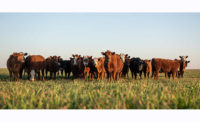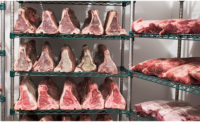The beef community has defined sustainability as raising cattle in a way that is environmentally sound, economically viable and socially responsible. However, accurately measuring sustainability using this holistic approach and developing practical on-ranch sustainability tools is challenging, as the beef supply chain is one of the most complex biological, economic and social systems in the world.
“While U.S. cattlemen are generally recognized by experts around the world for having top notch practices and environmental stewardship,” says Oklahoma rancher Richard Gebhart, “there is a lot of misinformation here in our own country about what we are doing to continuously improve how we raise beef to meet growing consumer needs in the future.”
The beef community — from farmers and ranchers to the feed yard, processors, grocery stores and restaurants — is committed to enhancing the sustainability of U.S. beef. Together these phases (funded by The Beef Checkoff) have embarked on a journey to better understand the current sustainability of beef and identify areas for improvement through a groundbreaking Beef Sustainability Assessment.
Multi-phase beef sustainability assessment
Sound science is essential to establishing sustainability goals. For that reason, cattle farmers and ranchers have invested their beef checkoff dollars in a significant, multi-year sustainability assessment — the first of its kind for an entire industry — that will benchmark beef sustainability and identify areas for improvement.
“That’s why it was important for us to fund this project,” explains Gebhart. “It will help us raise more sustainable beef over time by identifying opportunities to make continuous improvements in technologies and best-management practices into the future.”
The Beef Checkoff has partnered with BASF, a leading global supplier of ingredients for human and animal nutrition, to conduct a comprehensive sustainability assessment of the U.S. beef industry. With the help of the BASF S.E.T. (Sustainability, Eco-Efficiency, Traceability) tool, the project will quantify all system inputs and outputs, and identify areas of improvement in beef cattle management.
The project consists of three phases: 1) a hotspot analysis where data from a literature review and a stakeholder survey is evaluated; 2) a comprehensive life cycle assessment (ISO compliant) of the beef production system from cradle to grave; and 3) development of a tool for cattle farmers and ranchers to improve the sustainability of their operations.
“Most lifecycle assessments look only at the environmental impact of production,” says Dr. Bo Reagan, senior vice president of research, education and innovation for the National Cattlemen's Beef Association, a contractor to the Beef Checkoff Program on this project. “Our sustainability assessment is comprehensive as it will not only evaluate the environmental inputs and outputs for beef from pasture to plate, but also consider the economic and social aspects of the industry.”
When the project wraps at the end of the year, the entire beef community, as well as individual cattlemen, will have a sustainability baseline that will enable them to identify areas for improvement and work toward improving beef’s sustainability.
Environmental solutions
According to a recent United Nations population report, the global population will exceed 8.97 billion by 2050. The U.S. beef community is devoted to being a part of the team that makes feeding these additional people possible by meeting the global demand for nutrient-rich beef and reducing resource use and environmental impact.
Through the environmental life cycle assessment, all inputs (from fertilizers to packaging materials) that are required to raise a pound of edible beef will be assessed and considered as a part of the impact of beef. The environmental assessment is not exclusive to greenhouse gasses (as are many other lifecycle assessments) but also includes the impacts of water, energy, land use and air emissions. In this way, the beef community will be able to access and address specific high-impact areas along the supply chain that can most effectively be addressed in order to achieve long-term improvements.
Economic value
In this tough economic climate, it is imperative that sustainability takes into account the cost of production for all members along the beef value chain, including the end consumer. Economics plays hand-in-hand with both the environmental and social pillars of sustainability. Without economic stability, implementing good environmental practices, providing employees with positive benefits and customers with affordable products can prove to be challenging.
The beef community is extremely complex and depends on many different agriculture commodities to efficiently produce high-quality beef. Therefore, the economic assessment being employed is built in conjunction with both performance and environmental lifecycle assessments. This provides the industry with quality data that realistically depicts the production costs (or gains) of producing more sustainable beef.
Trust through social responsibility
Social responsibility is a cornerstone of the beef community. Cattlemen and women who raise beef care how their product impacts people; from the rural communities where they raise beef to consumers in urban centers. In fact, 70 percent of cattlemen say that it is very important to invest in local communities, including creating jobs, according to an Aspen Media and Market Research survey. Additionally, most ranches have been in the same family for multiple generations, and preserving the community for the future is top of mind.
The social lifecycle assessment provides measurable indicators for employees, future generations, local and national community, international community, and consumers. Using these parameters, the beef community will better understand how changes made in the economic and environmental pillars may impact social responsibility (and vice versa) to maximize sustainability and work toward a better beef community.
Influencer engagement
In addition to recognizing the need for a sustainability platform built on sound science, cattle farmers and ranchers understand the importance of building relationships with supply-chain decision makers and national thought leaders who are driving the conversation about how food is raised. For that reason, the Checkoff has partnered with state beef councils to host hands-on tours introducing sustainability conversation leaders to beef community practices.
Participants not only get a first-hand look at the pasture-to-plate process but also get access to on-the-ground experts who can answer pressing questions about how beef is raised.
As Mary Avant, assistant editor of QSR Magazine notes, “It was especially helpful to learn about all the sustainability efforts individuals and companies in the industry are making, as well as the advancements in food safety.”
The tours are designed to illustrate current sustainability practices, but also to generate momentum for greater collaboration by bringing together a diverse set of stakeholders to have a discussion on creating more sustainable beef.
Sustainability is not a new concept for farmers and ranchers who are dedicated to leaving their land, businesses and communities in better shape for the next generation. The goal remains the same: provide a growing population with high-quality, safe, nutritious beef. Addressing both scientific and consumer concerns regarding sustainable food production along all phases of the beef value chainwhile continuously improving the sustainability of beef will become a hallmark of the beef community in years to come.
America’s beef community is committed to finding environmental solutions, improving the economic value of their product and building trust through social responsibility.



Report Abusive Comment